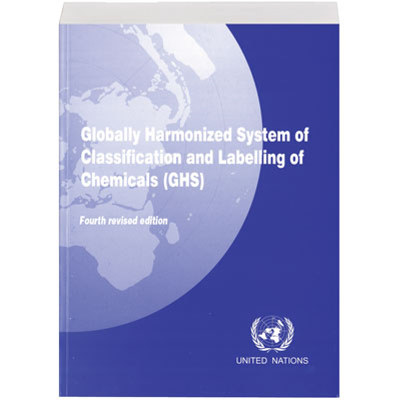 Much of the “buzz” in the U.S. regulatory community this year, at least in hazard communication, has been about a three letter acronym that may still be a mystery to many: “GHS.” What does this acronym stand for, and how will it affect you and your company as it relates to hazard communication?
Much of the “buzz” in the U.S. regulatory community this year, at least in hazard communication, has been about a three letter acronym that may still be a mystery to many: “GHS.” What does this acronym stand for, and how will it affect you and your company as it relates to hazard communication?
One thing that all workplaces have in common is the need to use both commercial and industrial chemicals and other substances and their constituent components in a safe and responsible manner. One impediment to the safe use of these substances has been the various international standards, rules and regulations that have evolved independently of one another. Each country had developed its own rules to inform citizens of the hazards associated with each substance. “Hazard communication” has been a hodge-podge of different types of information, presented in varying and often conflicting ways. As global trade increased through the years, the need to efficiently relay critical information about dangerous substances between nations became more pressing.
The U.S. Occupational Safety and Health Administration (OSHA) issued the first Hazard Communication Standard (HCS) in 1983. The goal was to standardize hazard communication information in the U.S. through regulatory standard US 29 CFR 1910.1200.
In the regulation’s preamble, the initial American rule called for international agreement on standards to assist in the “broadest recognition of the identified hazards.” OSHA has progressively updated and modified the standard through the years to reflect the advances of technology, industrial hygiene, risk management and health concerns over the intervening decades. However, as early as 1992, it was accepted that a standardized system was needed due to increased global trade. The United Nations recognized that such a global standard would have to be “user-friendly” by providing uniform and consistent information as well as pictorial displays of threats and hazards. Thus was born the Globally Harmonized System of Classification and Labelling of Chemicals, commonly known as “GHS.”
In 1992, the United Nations held the “Conference on Environment and Development” in Rio De Janeiro. During this event, a mandate was issued stating that “a globally harmonized hazard classification and compatible labeling system, including Material Safety Data Sheets (MSDS), and easily understandable symbols, should be available, if feasible, by the year 2000.” Though adoption as progressed slower than expected, GHS has worked its way into much of the international trade structure, especially in the European Union (EU). GHS harmonization has been an ongoing and much further advanced project in the transportation of dangerous goods, with the US DOT 49 CFR already significantly harmonized with international standards. However, until this year, the GHS has had little impact on the OSHA-directed HCS rules. That has changed!
For many years, the standard method for communicating hazard information in the U.S. has been through the use of and training in various types of hazard communication labels as well as the ubiquitous MSDS. In the previous iteration of 29 CFR 1910.1200, the purpose of the standard was made clear:
“…to ensure that the hazards of all chemicals produced or imported are evaluated, and that information concerning their hazards is transmitted to employers and employees. This transmittal of information is to be accomplished by means of comprehensive hazard communication programs, which are to include container labeling and other forms of warning, material safety data sheets, and employee training.”
The modification of the current HCS to a GHS-based system under the new OSHA rule1 implements significant change right from the beginning. Note the change in purpose invoked by the modified rule:
“…to ensure that the hazards of all chemicals produced or imported are classified, and that information concerning the classified hazards is transmitted to employers and employees. The requirements of this section are intended to be consistent with the provisions of the United Nations Globally Harmonized System of Classification and Labeling of Chemicals (GHS), Revision 3.”
Quite a difference! As you can see, OSHA has fully embraced the GHS-based system and is explicitly directing it be implemented across the board in the workplace.
As with any new or revised federal regulation, there is a timeline for compliance with its varying aspects. Here are the dates OSHA has set forth as required for implementation:
- May 26, 2012 – The new HCS is effective.
- December 1, 2013 – Employers must have employees trained regarding new label elements and safety data sheet formats.
- June 1, 2015 – Chemical manufacturers, importers, distributors, employers shall be in compliance with all modified provisions of the new HCS with the following exceptions:
- December 1, 2015 – Distributors shall not ship containers not labeled in compliance with the new HCS.
- June 1, 2016 – Any alternative workplace labeling shall be updated to conform to the HCS.
During the transition period, it is allowable to conform to either the HCS as promulgated on Oct. 11, 2011, or with the updated HCS. For more specific guidance, you should consult the standard itself or contact Labelmaster’s regulatory staff for clarification. If you are interested in a much more comprehensive review of this topic, as well as a set of guidance suggestions for how to proceed from here, Labelmaster has conducted an entire series of no-cost webinars on GHS implementation that are available on our YouTube page.
* * * * *
With the December 2013 GHS training deadline approaching quickly, companies should begin planning their GHS training sessions immediately. To help companies begin their transition to the revised hazcom standard, Labelmaster offers a variety of GHS-related products, including training programs and manuals, training cards and posters, and pictogram labels. Please contact us for more information on any these products.